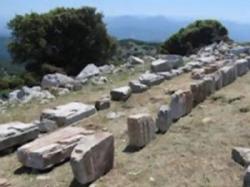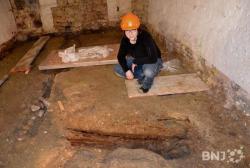INSTITUT SUPERIEUR D'ANTHROPOLOGIE
INSTITUTE OF ANTHROPOLOGY
ONLINE COURSES / COURS A DISTANCE
INSCRIPTION 2012 / Session III : Juillet 2012
REGISTRATION 2012 / Term III : July 2012
GRECE –  Messinia - Archaeological research reveals an ancient temple in the mountains between Ilia and Messinia, opposite the well-known imposing temple of Epicurean Apollo. The area around the newly discovered temple was full of architectural tools that were used to build a small temple, while former head of the 38th Ephorate of Antiquities, archaeologist Dr. Xeni Arapogianni explains that when the small temple was demolished in order to build a new one, topmasts, triglyphs and other parts of the ancient temple were found. The excavation started back in 2010, revealing the temple as well as bronze items and a great number of iron weapons and particularly sharp spears probably dedicated to the temple’s god, according to the Greek newspaper To Vima. A bronze figurine of a naked man, presumably a warrior as he’s holding a spear in its arm, was also found by the archaeologists. “That enables us to conclude that the temple was dedicated to a divine entity of war,” points out Dr. Arapogianni, underlying that the direct visual contact with the temple of Epicurean Apollo combined with the similarities of the votives, especially the spears, could mean that the temple was also dedicated to Apollo. That, however, does not exclude the possibility that goddesses Artemis or Athena were also worshipped there. “In my opinion, that was the first temple [in comparison with the one of the Epicurean Apollo], dated in the Archaic period, approximately at the 6th century B.C. It was probably built by Spartans, who conquered Messinia, and when Messinians were later liberated, they must have built a bigger temple in the same spot,” stresses the archaeologist.
Messinia - Archaeological research reveals an ancient temple in the mountains between Ilia and Messinia, opposite the well-known imposing temple of Epicurean Apollo. The area around the newly discovered temple was full of architectural tools that were used to build a small temple, while former head of the 38th Ephorate of Antiquities, archaeologist Dr. Xeni Arapogianni explains that when the small temple was demolished in order to build a new one, topmasts, triglyphs and other parts of the ancient temple were found. The excavation started back in 2010, revealing the temple as well as bronze items and a great number of iron weapons and particularly sharp spears probably dedicated to the temple’s god, according to the Greek newspaper To Vima. A bronze figurine of a naked man, presumably a warrior as he’s holding a spear in its arm, was also found by the archaeologists. “That enables us to conclude that the temple was dedicated to a divine entity of war,” points out Dr. Arapogianni, underlying that the direct visual contact with the temple of Epicurean Apollo combined with the similarities of the votives, especially the spears, could mean that the temple was also dedicated to Apollo. That, however, does not exclude the possibility that goddesses Artemis or Athena were also worshipped there. “In my opinion, that was the first temple [in comparison with the one of the Epicurean Apollo], dated in the Archaic period, approximately at the 6th century B.C. It was probably built by Spartans, who conquered Messinia, and when Messinians were later liberated, they must have built a bigger temple in the same spot,” stresses the archaeologist.
http://greece.greekreporter.com/2012/04/24/ancient-temple-discovered-in-messinia/
SUISSE –  Moutier - Le sous-sol de l’hôtel du Cerf permettra peut-être de percer le mystère du monastère de Moutier-Grandval. Des vestiges ont été trouvés dans la cave du bâtiment du 19e siècle, actuellement en rénovation. Il s’agit de restes de murs qui pourraient définir les limites d’une pièce ou du monastère lui-même. Ces vestiges remontent au Haut Moyen-Age, entre le 7e et le 13e siècle. Des sépultures plus tardives ont également été trouvées. Le Service archéologique du canton de Berne a investi les lieux. Pour Lara Tremblay, collaboratrice scientifique, la cave du Cerf recèle des «informations de la première importance». Les découvertes viendront compléter les fouilles réalisées à la rue Centrale en 2008 et 2009. La cave pourrait également receler les restes de l’église St-Marie, dont la construction est plus tardive que celle du monastère. L’emplacement de cet édifice religieux reste un mystère jusqu’ici.
Moutier - Le sous-sol de l’hôtel du Cerf permettra peut-être de percer le mystère du monastère de Moutier-Grandval. Des vestiges ont été trouvés dans la cave du bâtiment du 19e siècle, actuellement en rénovation. Il s’agit de restes de murs qui pourraient définir les limites d’une pièce ou du monastère lui-même. Ces vestiges remontent au Haut Moyen-Age, entre le 7e et le 13e siècle. Des sépultures plus tardives ont également été trouvées. Le Service archéologique du canton de Berne a investi les lieux. Pour Lara Tremblay, collaboratrice scientifique, la cave du Cerf recèle des «informations de la première importance». Les découvertes viendront compléter les fouilles réalisées à la rue Centrale en 2008 et 2009. La cave pourrait également receler les restes de l’église St-Marie, dont la construction est plus tardive que celle du monastère. L’emplacement de cet édifice religieux reste un mystère jusqu’ici.
http://www.rjb.ch/rjb/Actualites/Regionale/20120423-Une-cave-aux-tresors-insoupconnes.html
MEXIQUE – Chan Hol - One of the first humans to inhabit the Americas has been stolen – and archaeologists want it back.The skeleton, which is probably at least 10,000 years old, has disappeared from a cenote, or underground water reservoir, in Mexico's Yucatán Peninsula. The missing bones belong to a skeleton dubbed Young Hol Chan II, discovered in 2010. The cenote in which it was found had previously yielded another 10,000-year-old skeleton – the Young Man of Chan Hol, discovered in 2006. The earlier find has anatomical features suggesting shared heritage with Indonesians and south Asians. Other skeletons found in cenotes in the area with similar features may date to around 14,000 years ago. Such finds imply that not all early Americans came from north Asia. This deals yet another blow to the idea that the Clovis people crossing an ancient land bridge between Siberia and Alaska were the first to colonise the Americas. Clovis culture dates to around 13,000 years ago. Both skeletons were laid to rest at a time when sea level was much lower than it is today and the cenote, now about 8 metres below the water, was dry. Archaeologists have also found the remains of elephants, giant sloths and other animals in the caves, giving an indication of what the ancient humans ate.
Chan Hol - One of the first humans to inhabit the Americas has been stolen – and archaeologists want it back.The skeleton, which is probably at least 10,000 years old, has disappeared from a cenote, or underground water reservoir, in Mexico's Yucatán Peninsula. The missing bones belong to a skeleton dubbed Young Hol Chan II, discovered in 2010. The cenote in which it was found had previously yielded another 10,000-year-old skeleton – the Young Man of Chan Hol, discovered in 2006. The earlier find has anatomical features suggesting shared heritage with Indonesians and south Asians. Other skeletons found in cenotes in the area with similar features may date to around 14,000 years ago. Such finds imply that not all early Americans came from north Asia. This deals yet another blow to the idea that the Clovis people crossing an ancient land bridge between Siberia and Alaska were the first to colonise the Americas. Clovis culture dates to around 13,000 years ago. Both skeletons were laid to rest at a time when sea level was much lower than it is today and the cenote, now about 8 metres below the water, was dry. Archaeologists have also found the remains of elephants, giant sloths and other animals in the caves, giving an indication of what the ancient humans ate.
http://www.newscientist.com/article/dn21741-bones-of-ancient-american-stolen-from-underwater-cave.html?DCMP=OTC-rss&nsref=online-news
AUSTRALIE –  Kangaroo Island - A group of four archaeology students searched the sea and land on Kangaroo Island’s west coast earlier this month in a bid to find the historic Loch Sloy and the burial sites of 11 bodies recovered from the sea when the barque, en-route from Glasgow to Port Adelaide, sank on April 24, 1899. Records show 30 people, including the captain, six passengers and most crewmen, died when the ship ran into rocky waters while heading towards the Cape Borda lighthouse. There were four survivors, one of whom died after reaching land, but the exact location of the shipwreck and the bodies recovered from the waters, except for one, has remained a mystery.
Kangaroo Island - A group of four archaeology students searched the sea and land on Kangaroo Island’s west coast earlier this month in a bid to find the historic Loch Sloy and the burial sites of 11 bodies recovered from the sea when the barque, en-route from Glasgow to Port Adelaide, sank on April 24, 1899. Records show 30 people, including the captain, six passengers and most crewmen, died when the ship ran into rocky waters while heading towards the Cape Borda lighthouse. There were four survivors, one of whom died after reaching land, but the exact location of the shipwreck and the bodies recovered from the waters, except for one, has remained a mystery.
http://phys.org/news/2012-04-maritime-mystery.html
ROYAUME UNI –  Scilly - Islanders are being asked to help record how the sea is eroding Scilly’s historic coastal sites, before it’s too late. The areas that will be surveyed here include the bronze-age remains jutting out of the cliff at Halangy on St Mary’s and the Old Quay on St Martin’s, where 5,000 year old Neolithic pottery has been uncovered, There’ll also be work around the corner at Par Beach. A cow’s tooth, thought to originate in 4000BC was recently found there. Radiocarbon dating is expected to confirm it as one of the oldest examples of domestic animal rearing in the British Isles.
Scilly - Islanders are being asked to help record how the sea is eroding Scilly’s historic coastal sites, before it’s too late. The areas that will be surveyed here include the bronze-age remains jutting out of the cliff at Halangy on St Mary’s and the Old Quay on St Martin’s, where 5,000 year old Neolithic pottery has been uncovered, There’ll also be work around the corner at Par Beach. A cow’s tooth, thought to originate in 4000BC was recently found there. Radiocarbon dating is expected to confirm it as one of the oldest examples of domestic animal rearing in the British Isles.
http://www.scillytoday.com/2012/04/25/islanders-being-asked-to-record-threatened-archaeological-sites/